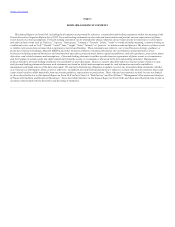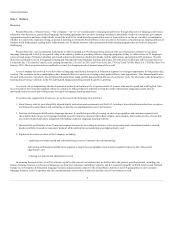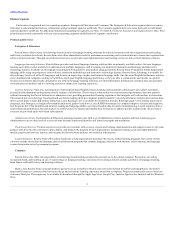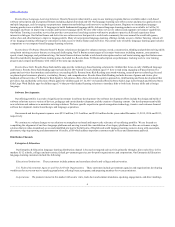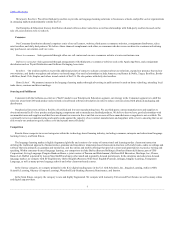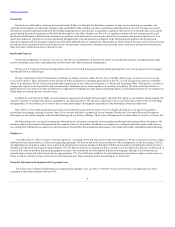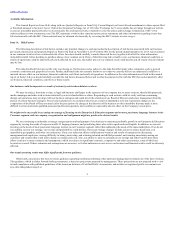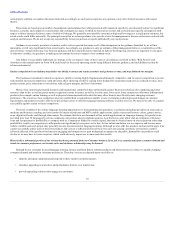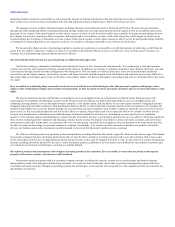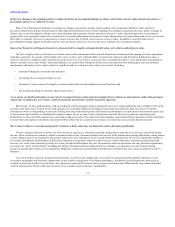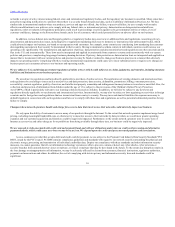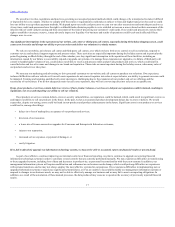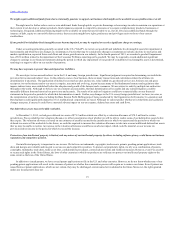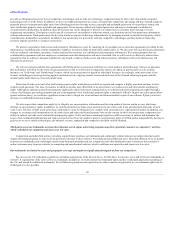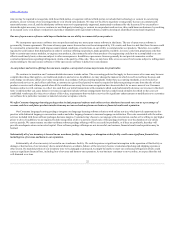Rosetta Stone 2015 Annual Report Download - page 14
Download and view the complete annual report
Please find page 14 of the 2015 Rosetta Stone annual report below. You can navigate through the pages in the report by either clicking on the pages listed below, or by using the keyword search tool below to find specific information within the annual report.
Table of Contents
marketing budget it cannot be assured that we can increase the amount of remnant advertising at the discounted prices we have obtained in the past. If any of
these events occur, we may be forced to purchase time slots and publication dates at higher prices, which will increase our costs.
We engage in an active public relations program, including through social media sites such as Facebook and Twitter. We also seek new customers
through our online marketing efforts, including paid search listings, banner ads, text links and permission-based e-mails, as well as our affiliate and reseller
programs. If one or more of the search engines or other online sources on which we rely for website traffic were to modify their general methodology for how
they display our websites, resulting in fewer consumers clicking through to our websites, our sales could suffer. If any free search engine on which we rely
begins charging fees for listing or placement, or if one or more of the search engines or other online sources on which we rely for purchased listings, modifies
or terminates its relationship with us, our expenses could rise, we could lose customers and traffic to our websites could decrease.
We dynamically adjust our mix of marketing programs to acquire new customers at a reasonable cost with the intention of achieving overall financial
goals. If we are unable to maintain or replace our sources of customers with similarly effective sources, or if the cost of our existing sources increases, our
customer levels and marketing expenses may be adversely affected.
Our international businesses may not succeed and impose additional and unique risks.
Our business strategy contemplates stabilizing and reducing the losses we have experienced internationally. We continuously review and optimize
certain of our website sales channels in Europe, Asia and Latin America. In addition, we continue to optimize our indirect sales channels in Europe, Asia and
Latin America through reseller and other arrangements with third parties. If we are unable to stabilize and reduce losses in our international operations
successfully and in a timely manner, our business, revenue, and financial results could be harmed. Such stabilization and reduction may be more difficult or
take longer than we anticipate, and we may not be able to successfully market, sell, deliver and support our products and services internationally to the extent
we expect.
If we are unable to continually adapt our products and services to mobile devices and technologies other than personal computers and laptops, and to
adapt to other technological changes and customer needs generally, we may be unable to attract and retain customers, and our revenue and business could
suffer.
We need to anticipate, develop and introduce new products, services and applications on a timely and cost-effective basis that keeps pace with
technological developments and changing customer needs. The process of developing new high technology products, services and applications and
enhancing existing products, services and applications is complex, costly and uncertain, and any failure by us to anticipate customers' changing needs and
emerging technological trends accurately could significantly harm our ability to attract and retain customers and our results of operations. For example, the
number of individuals who access the Internet through devices other than a personal computer, such as tablet computers, mobile devices, televisions and set-
top box devices, has increased dramatically and this trend is likely to continue. Our products and services may not work or be viewable on these devices
because each manufacturer or distributor may establish unique technical standards for such devices. Accordingly, we may need to devote significant
resources to the creation, support and maintenance of such versions. If we fail to develop or sell products and services on a cost-effective basis that respond to
these or other technological developments and changing customer needs, we may be harmed in our ability to attract and retain customers, and our revenue
and business could suffer. Furthermore, our customers who view our advertising via mobile devices might not buy our products to the same extent that they
do when viewing our advertising via personal computers or laptops. Accordingly, if we cannot convince customers to purchase our products via mobile
devices, our business and results of operations could be harmed to the extent that the trend to mobile devices continues.
We offer our software products on operating systems and platforms including Windows, Macintosh, Apple OS, Android, and Amazon apps. The demand
for personal computers has been declining, which means that we must be able to market to potential customers and to provide customers with access to and
use of our products and services on many platforms and operating systems, as they may be changed from time to time. To the extent new releases of operating
systems, including for mobile and non-PC devices, or other third-party products, platforms or devices make it more difficult for our products to perform, and
our customers use alternative technologies, our business could be harmed.
Our software products must interoperate with computer operating systems of our customers. If we are unable to ensure that our products interoperate
properly with customer systems, our business could be harmed.
Our products must interoperate with our customers' computer systems, including the network, security devices and settings, and student learning
management systems of our Enterprise & Education customers. As a result, we must continually ensure that our products interoperate properly with these
varied and customized systems. Changes in operating systems, the technologies we incorporate into our products or the computer systems our customers use
may damage our business.
13


